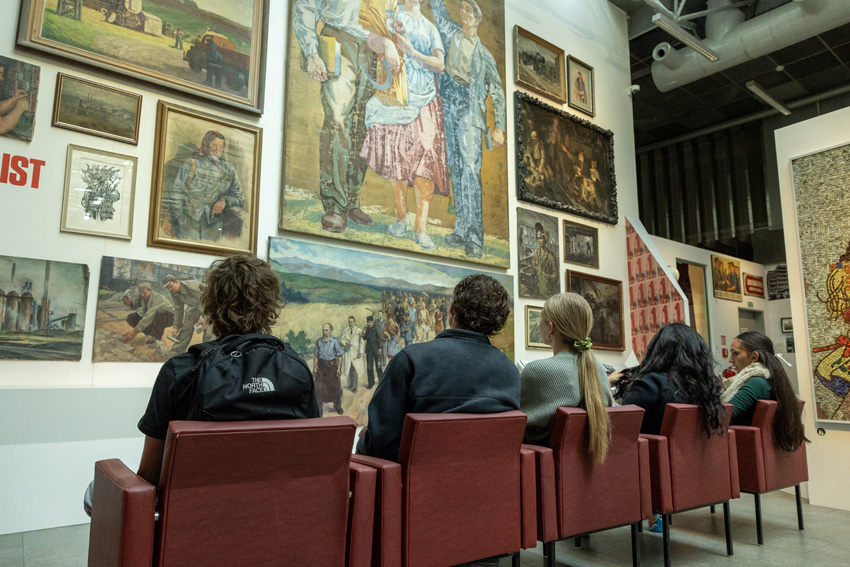
Day 1 of the fetal pig dissection
To cover the zoology class’ week-long experiment, The Feather will daily update this feature with the latest information. Check back daily to see new pictures and text about the dissections.
Day 1: April 8
At the beginning of the 2013-14 school year zoology was introduced to the assortment of science courses already present. Since then, its first-year teacher, Karen Walters, has provided the class with a series of dissections, experiments and a field trip to the Monterey Bay Aquarium.
The first animals in the curriculum were very simple, however as the year progressed so too did the complexity of the specimens. Currently students are studying the class Mammilla and have been provided a quite interesting learning resource.
The week-long dissection of a fetal pig evokes different responses from different people. Those who are squeamish find the assignment something less than pleasant. Others have no problem working with the specimen and may even have piqued their curiosity.
Sophomore zoology student Zoe House admits that she was a bit uncomfortable at first. However, once the dissection commenced she began to relax and was fascinated at what she learned.
“I was actually very anxious and nervous about the dissection at first,” House said. “Then when I started dissecting, I found out how interesting it was. It was cool to look at the different parts of the pig and then be able to identify them.”
On the first day, April 8, students became acquainted with their specimens and performed a few basic procedures. This included making incisions in the jaw of the animal so that students could open the mouth and observe the structures within. They also studied the eye and compared it to that of a human. By the end of class, some students had already started to open the body cavity and to explore the creature?s digestive system.
Juliana Rosik, sophomore zoology student, has been positively impacted. Rosik has considered a career as a surgical assistant and believes that this hands on experience will give her insight and help her defeat any squeamish tendencies.
“I?m getting used to working with the tools that I may have to work with some day,” Rosik said. “I’m not getting grossed out about it so that?s a good thing. It?s beneficial to me to look at something very similar to the human anatomy that?s not just on a diagram.”
Day 2: April 9
On the second day of the fetal pig dissection students further explored the digestive and respiratory system. For many, this second day was made easier than their prior experience. Yet for others the procedures still felt a bit out of their comfort zone.
Sophomore Zoology student Courtney Messer falls into the latter. Although she loves to learn about the pig?s anatomy she admits that she is still a bit squeamish and is content to watch and observe.
&%picture2placement%&
“I was actually more grossed out the second day because we dug further into the anatomy,” Messer said. “My first impression upon seeing the pig was disgust, and I thought it was a little sad too. I think that tomorrow I may be a little more used to it. Today I just liked to watch and encourage.”
Throughout the second day students moved at their own pace. Although they relied upon the help of a dissection guide and the supervision of zoology teacher Karen Walters, they worked with their assigned partner to explore the intestines, lungs and heart. This included using tools to cut, pry open and examine aspects of the specimen.
While this part was deemed “gross” by a large percentage of the class, some found it interesting. One of these was senior Ryan Stewart. Stewart?s father is a biologist and has acquainted his son with some of the procedures that he encountered during the dissection. Stewart says that he owes his lack of squeamish tendencies to his dad and actually enjoyed most of the dissection.
“Today I learned more about the pig?s body system and how it works,” Stewart said. “I?m sort of used to the whole dissection process because my dad is a biologist, and I have seen a lot of this stuff before. I wouldn?t say I?m very squeamish about this and I?m looking forward to doing this again tomorrow.”
Students concluded the day with their routine clean up and sanitation procedures. They plan to dig deeper and examine the individual organs closer during their next lab.
For more features, read the March 8 article, Mennonite Central Committee fundraises with annual event.
Follow The Feather via Twitter and Instagram: @thefeather and @thefeatheronlilne. This writer can be reached via Twitter: @skylerklee.







MIchelle Devereaux • Aug 30, 2014 at 2:36 am
This brought tears to my eyes. What a blessing they are!